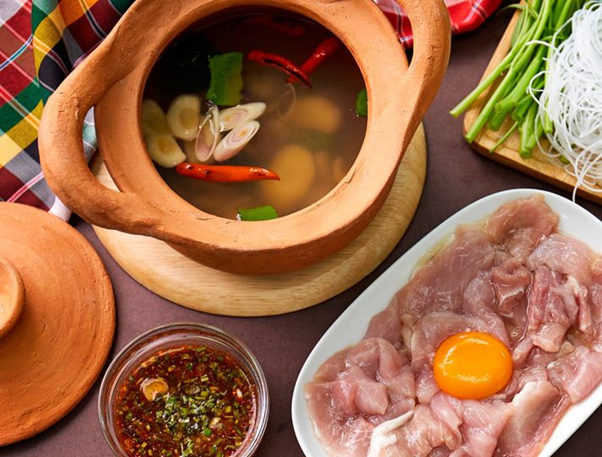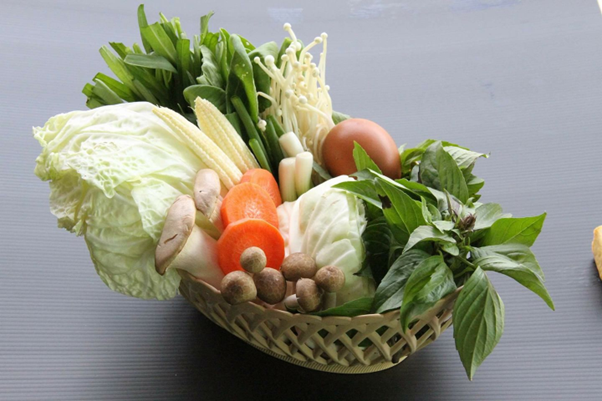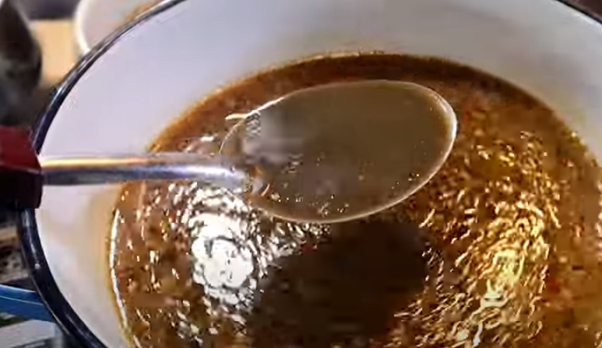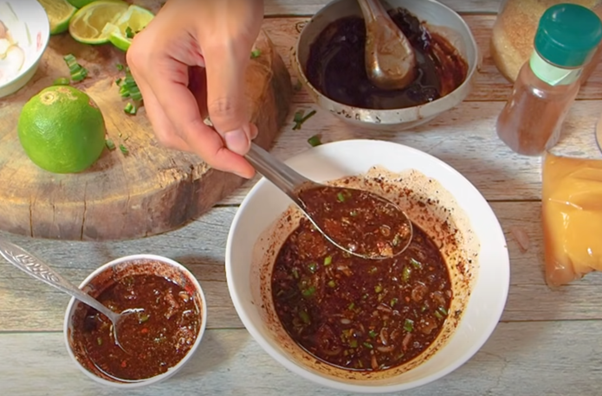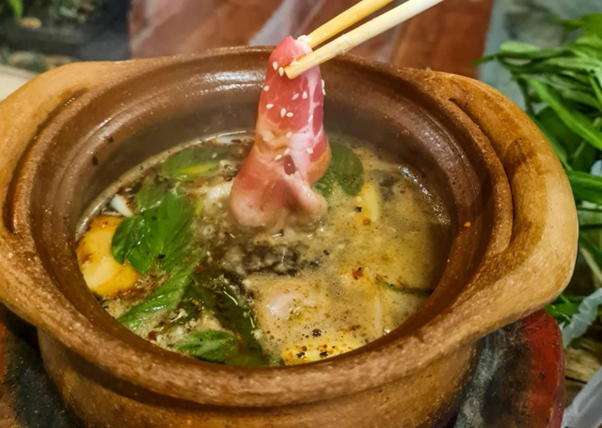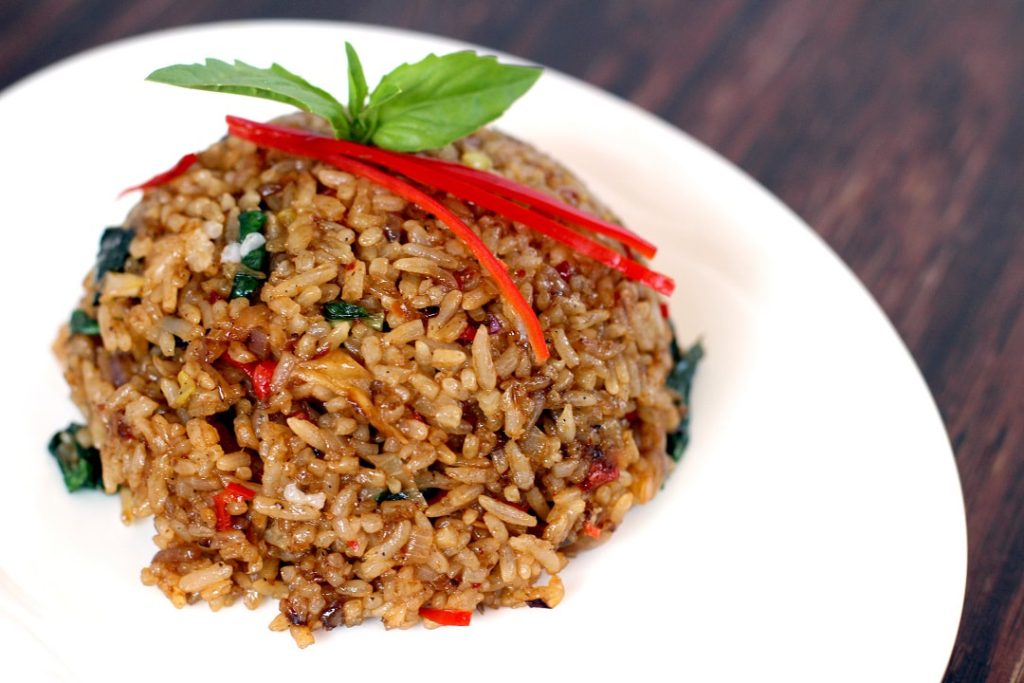When I think of hotpot the first thing that comes to mind is a cold winter’s night, chopsticks in hand and sitting around a big pot of spicy boiling broth – the perfect combination for keeping anyone full and warm. In Thailand where it’s hot and humid for most of the year, you might be surprised to know that there is also something called Jaew Hon or Jim Jum which is a Thai version of the hotpot.
The Thai hotpot spread (Image source | Mao Moo Jum)
Jim Jum (read: jim-joom) meaning ‘dip dunk’ in Thai describes the action of dunking food into hot broth before dipping it into nam jim (dipping sauce).Yes, the name is back to front! Traditionally, Jim Jum is done in a small Thai-styled terracotta pot over another pot housing hot charcoal. The broth is clear, fragrant and herbaceous and the dipping sauce salty, spicy and sour. Raw meat such as pork or beef and fresh vegetables like morning glory, Chinese cabbage and Thai basil are laid out on plates beside ready to be dunked in the boiling broth
Vegetable platter for cooking in the hotpot (Image source | Jimjoom Ti Saphan 2)
The origin of this dish seems to go back to Isaan, the northeastern part of Thailand where it’s locally called Jaew Hon. In the Isaan language, jeaw means sauce and hon means hot describing the flavourful sauce that is mixed with hot broth. Isaan food has a distinct taste – heavily seasoned, very spicy, sour, topped with fresh herbs and has strong influences from the region’s bordering countries, Laos and Cambodia. The broth in Jaew Hon is still very fragrant and herbaceous like the more modern Jim Jum but with a few additional ingredients. It is darker, usually made by mixing jaew which is a flavourful sauce made with blended up roasted aromatic ingredients and bone broth. This sometimes contains pork or beef blood and has a bit of bitterness from kee pia.
If you’re familiar with food from Laos or the Isaan region you might already know what this is, otherwise strap yourselves in! Kee pia, the word kee meaning poop (yep you read that right) is an ingredient taken from the intestines of grass eating animals such as cows, buffalos and goats. It is a mixture of digestive enzymes and semi digested grass and fibres with a dark greenish brown colour which adds an earthy bitterness to food. This is also sometimes added to the dipping sauce eaten with Jaew Hon.
Adding kee pia to Jaew Hon broth (Image source | Zappakpo)
If you want to try making Jim Jum at home, here’s how to :
The broth
– 1L pork bone stock (use different stock to suit your dietary requirements, if vegetarian use veggie stock)
– 5-6 kaffir lime leaves – torn up
– 1 stick of lemongrass – smashed and chopped up in small logs
– 3 shallots – cut into chunks
– 6-7 slices of galangal
– Fresh red chillies to taste
– Salt or fish sauce to taste
Nam jim jaew (the dipping sauce) from Mai’s Kitchen
– 1 tbsp palm sugar
– 3 tbsp fish sauce
– 3 tbsp tamarind juice
– 2 tbsp lime juice
– 1 tbsp roasted chilli powder
– 1-2 tbsp sliced shallots
– 1-2 tbsp chopped up saw-toothed coriander
– 1 tbsp toasted rice powder
Things to cook in the broth
This is up to your preference and what you have on hand but below are some suggestions for a classic experience!
– Vegetables : Chinese cabbage, morning glory, slices of carrots, Thai basil, Chinese celery, saw-toothed coriander
– Meat : sliced up marinated pork or beef, liver, prawns, squid
– Noodles : vermicelli or instant noodles
– Mushrooms : enoki, oyster
– Egg
Nam jim jaew – the spicy, salty, sour dipping sauce (Image source | Mai’s Kitchen)
To make the broth, bring the stock up to a gentle boil and add kaffir lime leaves, lemongrass, shallots, galangal and chilli. Season with a bit of salt or fish sauce to taste. While letting the broth simmer, mix all the ingredients to make the dipping sauce, making sure the palm sugar is completely dissolved. Adjust the flavours to taste if needed then you’re ready to get the Jim Jum party started!
I like to put in the aromatic herbs first to add even more flavour to the broth, then vegetables that take longer to cook. People also often crack an egg on their meat platter, dipping the meat into the yolk before cooking it. Dunk and dip as you go and don’t forget the dipping sauce!
Dunk in! (Image source | Jenjira Kantatam)
Nowadays in Thailand many restaurants have modernised the dish and you can enjoy it in electric pots indoors at any time of day in the comfort of air-conditioning, many in an all you can eat style. However when you go past some Isaan restaurants you will still see people enjoying themselves outdoors, at night when the heat of the sun has left, surrounding a little terracotta vessel – sharing stories as they share the pot.
Article by Oun V.
References


